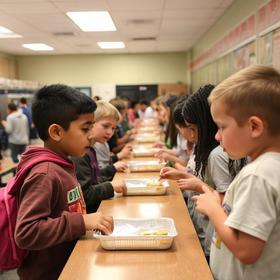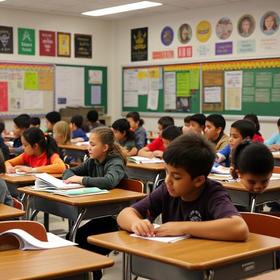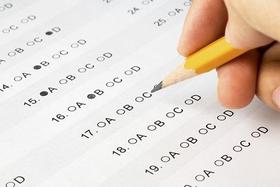Douglas Byrd High School is a four-year public high school located in Fayetteville, North Carolina. Their mascot is the Eagle.
Serving 1,002 students in grades 9-12, Douglas Byrd High School ranks in the bottom 50% of all schools in North Carolina for overall test scores (math proficiency is bottom 50%, and reading proficiency is bottom 50%).
The percentage of students achieving proficiency in math is 25-29% (which is lower than the North Carolina state average of 51%). The percentage of students achieving proficiency in reading/language arts is 40-44% (which is lower than the North Carolina state average of 50%).
The student-teacher ratio of 15:1 is equal to the North Carolina state level of 15:1.
Minority enrollment is 87% of the student body (majority Black), which is higher than the North Carolina state average of 57% (majority Black).
Quick Facts (2025-26)
- Grades: 9-12
- Enrollment: 1,002 students
- Student-Teacher Ratio: 15:1
- Minority Enrollment: 87%
- Graduation Rate: 67% (Btm 50% in NC)
- Overall Testing Rank: Bottom 50%
- Math Proficiency: 25-29% (Btm 50%)
- Reading Proficiency: 40-44% (Btm 50%)
- Science Proficiency: 25-29% (Btm 50%)
- Source: National Center for Education Statistics (NCES), NC Dept. of Education
Top Rankings
Douglas Byrd High School ranks among the top 20% of public schools in North Carolina for:
Category
Attribute
Percent Eligible For Free Lunch
School Overview
Douglas Byrd High School's student population of 1,002 students has declined by 9% over five school years.
The teacher population of 65 teachers has declined by 13% over five school years.
Grades Offered
Grades 9-12
(Supplemental Virtual)
(Supplemental Virtual)
Total Students
1,002 students
Gender %
Total Classroom Teachers
65 teachers
Year Founded
1972
Colors
Maroon, Gold
School Calendar
Last Day of School
Mon. May 25, 2026
School Motto
Excellence in Education
School Rankings
Douglas Byrd High School ranks within the bottom 50% of all 2,617 schools in North Carolina (based off of combined math and reading proficiency testing data).
The diversity score of Douglas Byrd High School is 0.66, which is less than the diversity score at state average of 0.71. The school's diversity has stayed relatively flat over five school years.
Overall Testing Rank
#1974 out of 2617 schools
(Bottom 50%)
(Bottom 50%)
Math Test Scores (% Proficient)
(21-22)25-29%
51%
Reading/Language Arts Test Scores (% Proficient)
40-44%
50%
Science Test Scores (% Proficient)
25-29%
63%
Student-Teacher Ratio
15:1
15:1
American Indian
2%
1%
Asian
1%
4%
Hispanic
21%
21%
Black
52%
25%
White
13%
43%
Hawaiian
1%
n/a
Two or more races
10%
6%
All Ethnic Groups
Graduation Rate
(21-22)67%
86%
Participates in the National School Lunch Program (NSLP)
Yes
Eligible for Free Lunch
98%
68%
Eligible for Reduced Lunch (17-18)
5%
4%
School Statewide Testing
School District Name
Source: National Center for Education Statistics (NCES), NC Dept. of Education
Profile last updated: 02/09/2025
Frequently Asked Questions
What is Douglas Byrd High School's ranking?
Douglas Byrd High School is ranked #1974 out of 2,617 schools, which ranks it among the bottom 50% of public schools in North Carolina.
What schools are Douglas Byrd High School often compared to?
Douglas Byrd High Schoolis often viewed alongside schools like Seventy-first High School by visitors of our site.
What percent of students have achieved state testing proficiency in math and reading?
25-29% of students have achieved math proficiency (compared to the 51% NC state average), while 40-44% of students have achieved reading proficiency (compared to the 50% NC state average).
What is the graduation rate of Douglas Byrd High School?
The graduation rate of Douglas Byrd High School is 67%, which is lower than the North Carolina state average of 86%.
How many students attend Douglas Byrd High School?
1,002 students attend Douglas Byrd High School.
What is the racial composition of the student body?
52% of Douglas Byrd High School students are Black, 21% of students are Hispanic, 13% of students are White, 10% of students are Two or more races, 2% of students are American Indian, 1% of students are Asian, and 1% of students are Hawaiian.
What is the student-teacher ratio of Douglas Byrd High School?
Douglas Byrd High School has a student ration of 15:1, which is equal to the North Carolina state average of 15:1.
What grades does Douglas Byrd High School offer ?
Douglas Byrd High School offers enrollment in grades 9-12 (Supplemental Virtual).
What school district is Douglas Byrd High School part of?
Douglas Byrd High School is part of Cumberland County Schools.
In what neighborhood is Douglas Byrd High School located?
Douglas Byrd High School is located in the Douglas Byrd neighborhood of Fayetteville, NC. There are 14 other public schools located in Douglas Byrd.
School Reviews
2 10/10/2025
The academic level of Douglas Byrd High is poor. How can are children learn when their is so much fighting going on in the classrooms. And the teachers take off so much that on any given day a substitute teacher is in the same classes always.
2 10/10/2025
i luv this school.
2 10/10/2025
The teachers do not teach they use poor grammar and they curse just as much as the students.
Review Douglas Byrd High School. Reviews should be a few sentences in length. Please include any comments on:
- Quality of academic programs, teachers, and facilities
- Availability of music, art, sports and other extracurricular activities
Recent Articles

How Public Schools Support Students on Free / Reduced-Lunch Programs
Explore how U.S. public schools support students eligible for free or reduced-price lunch through nutrition, academic, and wraparound services in 2025.

Hidden Costs of Public Schools: Fees, Supplies & Extras
Explore the hidden costs in public schools—fees, supplies, extracurriculars—and how parents can plan for them in 2025.

Public School Funding 2025: What Families Should Know
Essential insights on public school funding in 2025—how it works, what’s changing, and what families should know to stay ahead.








